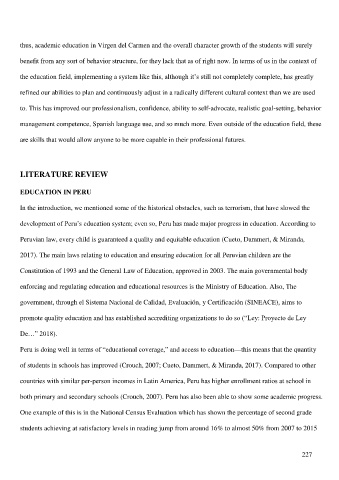Page 227 - ce_cusco_2019
P. 227
thus, academic education in Virgen del Carmen and the overall character growth of the students will surely
benefit from any sort of behavior structure, for they lack that as of right now. In terms of us in the context of
the education field, implementing a system like this, although it’s still not completely complete, has greatly
refined our abilities to plan and continuously adjust in a radically different cultural context than we are used
to. This has improved our professionalism, confidence, ability to self-advocate, realistic goal-setting, behavior
management competence, Spanish language use, and so much more. Even outside of the education field, these
are skills that would allow anyone to be more capable in their professional futures.
LITERATURE REVIEW
EDUCATION IN PERU
In the introduction, we mentioned some of the historical obstacles, such as terrorism, that have slowed the
development of Peru’s education system; even so, Peru has made major progress in education. According to
Peruvian law, every child is guaranteed a quality and equitable education (Cueto, Dammert, & Miranda,
2017). The main laws relating to education and ensuring education for all Peruvian children are the
Constitution of 1993 and the General Law of Education, approved in 2003. The main governmental body
enforcing and regulating education and educational resources is the Ministry of Education. Also, The
government, through el Sistema Nacional de Calidad, Evaluación, y Certificación (SINEACE), aims to
promote quality education and has established accrediting organizations to do so (“Ley: Proyecto de Ley
De…” 2018).
Peru is doing well in terms of “educational coverage,” and access to education—this means that the quantity
of students in schools has improved (Crouch, 2007; Cueto, Dammert, & Miranda, 2017). Compared to other
countries with similar per-person incomes in Latin America, Peru has higher enrollment ratios at school in
both primary and secondary schools (Crouch, 2007). Peru has also been able to show some academic progress.
One example of this is in the National Census Evaluation which has shown the percentage of second grade
students achieving at satisfactory levels in reading jump from around 16% to almost 50% from 2007 to 2015
227

